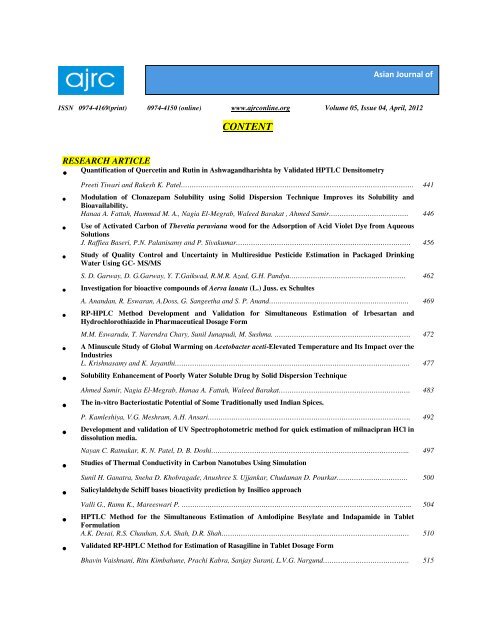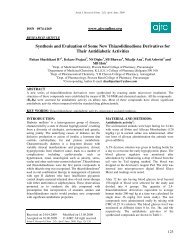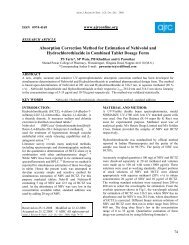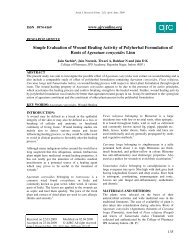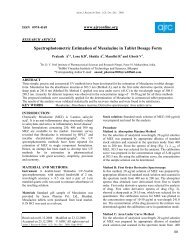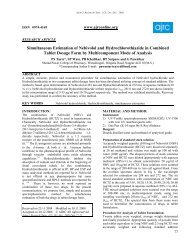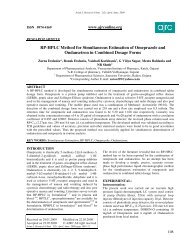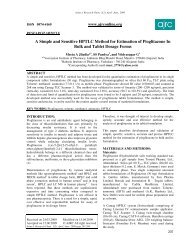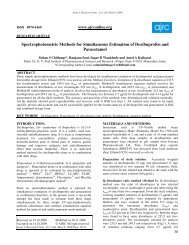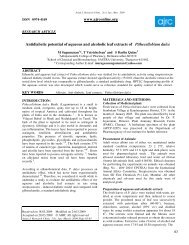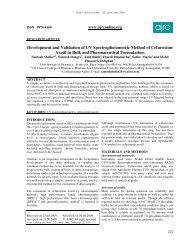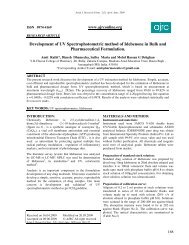Issue-4_April - Asian Journal of Research in Chemistry (AJRC)
Issue-4_April - Asian Journal of Research in Chemistry (AJRC)
Issue-4_April - Asian Journal of Research in Chemistry (AJRC)
Create successful ePaper yourself
Turn your PDF publications into a flip-book with our unique Google optimized e-Paper software.
ISSN 0974-4169(pr<strong>in</strong>t) 0974-4150 (onl<strong>in</strong>e) www.ajrconl<strong>in</strong>e.org Volume 05, <strong>Issue</strong> 04, <strong>April</strong>, 2012<br />
RESEARCH ARTICLE<br />
•<br />
CONTENT<br />
Quantification <strong>of</strong> Quercet<strong>in</strong> and Rut<strong>in</strong> <strong>in</strong> Ashwagandharishta by Validated HPTLC Densitometry<br />
<br />
<br />
Preeti Tiwari and Rakesh K. Patel……………………………………………………………………………………………… 441<br />
•<br />
Modulation <strong>of</strong> Clonazepam Solubility us<strong>in</strong>g Solid Dispersion Technique Improves its Solubility and<br />
Bioavailability.<br />
Hanaa A. Fattah, Hammad M. A., Nagia El-Megrab, Waleed Barakat , Ahmed Samir………………………………. 446<br />
•<br />
Use <strong>of</strong> Activated Carbon <strong>of</strong> Thevetia peruviana wood for the Adsorption <strong>of</strong> Acid Violet Dye from Aqueous<br />
Solutions<br />
J. Raffiea Baseri, P.N. Palanisamy and P. Sivakumar……………………………………………………………………… 456<br />
•<br />
Study <strong>of</strong> Quality Control and Uncerta<strong>in</strong>ty <strong>in</strong> Multiresidue Pesticide Estimation <strong>in</strong> Packaged Dr<strong>in</strong>k<strong>in</strong>g<br />
Water Us<strong>in</strong>g GC- MS/MS<br />
S. D. Garway, D. G.Garway, Y. T.Gaikwad, R.M.R. Azad, G.H. Pandya……………………………………………… 462<br />
•<br />
Investigation for bioactive compounds <strong>of</strong> Aerva lanata (L.) Juss. ex Schultes<br />
A. Anandan, R. Eswaran, A.Doss, G. Sangeetha and S. P. Anand……………………………………………………….. 469<br />
•<br />
RP-HPLC Method Development and Validation for Simultaneous Estimation <strong>of</strong> Irbesartan and<br />
Hydrochlorothiazide <strong>in</strong> Pharmaceutical Dosage Form<br />
M.M. Eswarudu, T. Narendra Chary, Sunil Junapudi, M. Sushma. ……………………………………………………… 472<br />
•<br />
A M<strong>in</strong>uscule Study <strong>of</strong> Global Warm<strong>in</strong>g on Acetobacter aceti-Elevated Temperature and Its Impact over the<br />
Industries<br />
L. Krishnasamy and K. Jayanthi………………………………………………………………………………………………. 477<br />
•<br />
Solubility Enhancement <strong>of</strong> Poorly Water Soluble Drug by Solid Dispersion Technique<br />
Ahmed Samir, Nagia El-Megrab, Hanaa A. Fattah, Waleed Barakat……………………………………………………. 483<br />
•<br />
The <strong>in</strong>-vitro Bacteriostatic Potential <strong>of</strong> Some Traditionally used Indian Spices.<br />
P. Kamleshiya, V.G. Meshram, A.H. Ansari…………………………………………………………………………………. 492<br />
•<br />
Development and validation <strong>of</strong> UV Spectrophotometric method for quick estimation <strong>of</strong> milnacipran HCl <strong>in</strong><br />
dissolution media.<br />
Nayan C. Ratnakar, K. N. Patel, D. B. Doshi……………………………………………………………………………….. 497<br />
•<br />
Studies <strong>of</strong> Thermal Conductivity <strong>in</strong> Carbon Nanotubes Us<strong>in</strong>g Simulation<br />
Sunil H. Ganatra, Sneha D. Khobragade, Anushree S. Ujjankar, Chudaman D. Pourkar…………………………… 500<br />
•<br />
Salicylaldehyde Schiff bases bioactivity prediction by Insilico approach<br />
Valli G., Ramu K., Mareeswari P. …………………………………………………………………………………………….. 504<br />
•<br />
HPTLC Method for the Simultaneous Estimation <strong>of</strong> Amlodip<strong>in</strong>e Besylate and Indapamide <strong>in</strong> Tablet<br />
Formulation<br />
A.K. Desai, R.S. Chauhan, S.A. Shah, D.R. Shah…………………………………………………………………………… 510<br />
•<br />
Validated RP-HPLC Method for Estimation <strong>of</strong> Rasagil<strong>in</strong>e <strong>in</strong> Tablet Dosage Form<br />
Bhav<strong>in</strong> Vaishnani, Ritu Kimbahune, Prachi Kabra, Sanjay Surani, L.V.G. Nargund…………………………………. 515
•<br />
Surfactants as Corrosion Inhibitors for Carbon Steel <strong>in</strong> Hydrochloric acid Solution<br />
Diwan S<strong>in</strong>gh Rajan and Dr. Shiv Darshan Malik…………………………………………………………………………… 520<br />
•<br />
UV-Spectrophotometric Determ<strong>in</strong>ation <strong>of</strong> Acephate and Pr<strong>of</strong>en<strong>of</strong>os (organophosphate) Pesticides <strong>in</strong> Buffer<br />
Medium<br />
N.V.S. Venugopal and B. Sumalatha………………………………………………………………………………………….. 526<br />
•<br />
Design, Synthesis and Physico-Chemical Investigation <strong>of</strong> the Iron (II) Complexes Conta<strong>in</strong><strong>in</strong>g Heterocyclic<br />
Nitrogen Donor Ligands<br />
S.K. Khatua, S.C. Nayak, P.K.Das, R.R. Gu<strong>in</strong>………………………………………………………………………………. 529<br />
•<br />
Design, Synthesis and Characterization <strong>of</strong> Some Novel Am<strong>in</strong>o and Aldehyde Substituted<br />
Azaphenothiaz<strong>in</strong>es<br />
Dhiraj Raghuvanshi, Pramod Kumar Sharma, Nimita Manocha, Shikha Agrawal, Prerna Chaturvedi……………. 532<br />
•<br />
Ion-Pair Spectrophotometric Estimation <strong>of</strong> Cipr<strong>of</strong>loxac<strong>in</strong> <strong>in</strong> bulk and pharmaceutical formulations<br />
A. S. Grewal, S. K. Patro, S. K. Kanungo……………………………………………………………………………………. 537<br />
•<br />
Removal <strong>of</strong> Chromium (III) from dr<strong>in</strong>k<strong>in</strong>g water us<strong>in</strong>g ash <strong>of</strong> bark <strong>of</strong> Term<strong>in</strong>alia arjuna<br />
M.N.Thakuria and A. K. Talukdar…………………………………………………………………………………………….. 541<br />
•<br />
Synthesis and Characterization <strong>of</strong> Some Complexes <strong>of</strong> Potassium (I) With 1,4,7,10,13,16-<br />
Hexaoxacyclooctadecane<br />
Rajeev Ranjan and Ramjatan S<strong>in</strong>ha…………………………………………………………………………………………. 547<br />
•<br />
Equilibrium Dialysis Studies on the Interaction <strong>of</strong> some Surfactants with Poly(N-v<strong>in</strong>yl-2-pyrrolidone) and<br />
Bov<strong>in</strong>e Serum Album<strong>in</strong><br />
Ashok Kumar, O.P. Yadav……………………………………………………………………………………………………… 552<br />
•<br />
Comparison Study <strong>of</strong> CNS Depressant Study <strong>of</strong> Synthesized Schiff Bases <strong>of</strong> Mannich Bases <strong>of</strong><br />
Resacetophenone Hav<strong>in</strong>g Variable Electronegative Atoms (:O:/:S:/:NH)<br />
Arpit D. Shah, Devanshi J. Raval, Nisha D. Pandya, Sunita J. Panchal, Viraj P. Jatakiya and Dr. Dhrubo Jyoti Sen……. 556<br />
REVIEW ARTICLE<br />
•<br />
Liquid Crystal- a Review<br />
Abhijit Ray…………………………………………………………………………………………………………………………. 563<br />
•<br />
Instruction to author .................................................................................................................................................. 568
Abstract<br />
RESEARCH ARTICLE<br />
Quantification <strong>of</strong> Quercet<strong>in</strong> and Rut<strong>in</strong> <strong>in</strong> Ashwagandharishta by Validated HPTLC Densitometry<br />
Preeti Tiwari 1 * and Rakesh K. Patel 2 ……………………………………………………………………………………….441<br />
1 Department <strong>of</strong> Pharmacognosy, Shri Sarvajanik Pharmacy College, Mehsana-384001, India.<br />
2 Head <strong>of</strong> Department <strong>of</strong> Pharmacognosy, Shri S. K. Patel College <strong>of</strong> Pharmaceutical Education and <strong>Research</strong>,<br />
Kherva-382711, India<br />
ABSTRACT:<br />
Ashwagandharishta is a polyherbal hydro-alcoholic formulation and is used as immunomodulator to promote the<br />
health and longevity by <strong>in</strong>creas<strong>in</strong>g defence aga<strong>in</strong>st disease and also known for its usefulness <strong>in</strong> the treatment <strong>of</strong><br />
hypercholesterolemia. A simple, precise and accurate HPTLC method has been established for the determ<strong>in</strong>ation <strong>of</strong><br />
quercet<strong>in</strong> and rut<strong>in</strong> <strong>in</strong> Ashwagandharishta–T and Ashwagandharishta-M prepared by traditional and modern<br />
methods respectively and also <strong>in</strong> its marketed formulation. The developed HPTLC method was validated <strong>in</strong> terms <strong>of</strong><br />
precision, accuracy, LOD, LOQ and specificity. The amount <strong>of</strong> quercet<strong>in</strong> <strong>in</strong> Ashwagandharishta-T, M and its<br />
marketed formulation was found to be 0.0021, 0.00192 and 0.00197 % w/w respectively while rut<strong>in</strong> was found to be<br />
0.00469, 0.00441 and 0.00464 % w/w respectively. This is the first report for the quantification <strong>of</strong> quercet<strong>in</strong> and<br />
rut<strong>in</strong> <strong>in</strong> Ashwagandharishta by HPTLC. Furthermore, no TLC densitometric methods have been reported for the<br />
quantification <strong>of</strong> quercet<strong>in</strong> and rut<strong>in</strong> from Ashwagandharishta.<br />
Modulation <strong>of</strong> Clonazepam Solubility us<strong>in</strong>g Solid Dispersion Technique Improves its Solubility and<br />
Bioavailability.<br />
Hanaa A. Fattah 1 , Hammad M. A. 1 , Nagia El-Megrab 1 , Waleed Barakat 2 , Ahmed Samir 1 ………………………446<br />
1 Department <strong>of</strong> Pharmaceutics, Faculty <strong>of</strong> Pharmacy, Zagazig University, Egypt.<br />
2 Department <strong>of</strong> Pharmacology, Faculty <strong>of</strong> Pharmacy, Zagazig University, Egypt.<br />
ABSTRACT:<br />
The pharmacologic efficacy <strong>of</strong> benzodiazep<strong>in</strong>es (as clonazepam, CZP) <strong>in</strong> controll<strong>in</strong>g seizures is directly associated<br />
with their plasma concentration. An emergent epileptic situation necessitates rapid drug absorption. parentral<br />
adm<strong>in</strong>istration is not convenient <strong>in</strong> epileptic emergency and oral bioavailability <strong>of</strong> CZP is limited by its poor water<br />
solubility.<br />
Solid dispersion formulations were developed by physical mixture and solvent evaporation us<strong>in</strong>g CZP with the<br />
carriers polyv<strong>in</strong>yl pyrrolidone K30 (PVP K30, 1:4) or polyethylene glycol 4000 (PEG 4000, 1:4).<br />
Analysis <strong>of</strong> the solid dispersions by FTIR, DSC, XRD and dissolution studies showed that CZP was molecularly<br />
dispersed <strong>in</strong> an amorphous form and <strong>in</strong>dicate <strong>in</strong>creased dissolution rate.<br />
In addition, the oral bioavailability <strong>of</strong> the formulations was significantly improved reach<strong>in</strong>g therapeutic levels with<strong>in</strong><br />
30 and 60 m<strong>in</strong> <strong>in</strong> case <strong>of</strong> PEG 4000 and PVP K30 respectively follow<strong>in</strong>g oral adm<strong>in</strong>istration to mice.<br />
In conclusion; PVP K 30 and PEG 4000 can be utilized to <strong>in</strong>crease the solubility <strong>of</strong> CZP and enhance its oral<br />
bioavailability.<br />
Use <strong>of</strong> Activated Carbon <strong>of</strong> Thevetia peruviana wood for the Adsorption <strong>of</strong> Acid Violet Dye from Aqueous<br />
Solutions<br />
J. Raffiea Baseri 1 , P.N. Palanisamy 2 and P. Sivakumar 3 ………………………………………………………………..456<br />
1 Department <strong>of</strong> <strong>Chemistry</strong>, Al-Ameen Eng<strong>in</strong>eer<strong>in</strong>g College, Erode, Tamilnadu-638 104, India<br />
2 Department <strong>of</strong> <strong>Chemistry</strong>, Kongu Eng<strong>in</strong>eer<strong>in</strong>g College, Perundurai, Erode, Tamilnadu- 638 052,India<br />
3 Department <strong>of</strong> <strong>Chemistry</strong>, Arignar Anna Government Arts College, Namakkal, Tamilnadu- 637 002, India
ABSTRACT:<br />
Activated carbon prepared from Thevetia peruviana wood was used as an adsorbent for the removal <strong>of</strong> Acid Violet<br />
49 from aqueous solutions. Batch adsorption experiments were performed for adsorption k<strong>in</strong>etics and isotherm by<br />
vary<strong>in</strong>g temperature, <strong>in</strong>itial dye concentration, pH and time. The amount <strong>of</strong> dye adsorbed <strong>in</strong>creased while <strong>in</strong>creas<strong>in</strong>g<br />
the <strong>in</strong>itial concentration and temperature <strong>of</strong> the solution. The experimental data fitted well to Pseudo second order<br />
k<strong>in</strong>etic model with Intra particle diffusion as the rate determ<strong>in</strong><strong>in</strong>g step. Adsorption data fitted with Langmuir model.<br />
The negative value <strong>of</strong> Gibb’s free energy (G°) <strong>in</strong>dicated that the adsorption was spontaneous <strong>in</strong> nature. The results<br />
showed that the activated carbon <strong>of</strong> Thevetia peruviana was suitable for the removal <strong>of</strong> the acidic dyes from the<br />
aqueous solutions. The positive value <strong>of</strong> enthalpy ( ) <strong>in</strong>dicated that the adsorption <strong>of</strong> the selected dyes were<br />
endothermic.<br />
KEYWORDS : Thevetia Peruviana, Adsorption, Dyes, Acid Violet 49, k<strong>in</strong>etics, Activated carbon.<br />
Study <strong>of</strong> Quality Control and Uncerta<strong>in</strong>ty <strong>in</strong> Multiresidue Pesticide Estimation <strong>in</strong> Packaged Dr<strong>in</strong>k<strong>in</strong>g Water<br />
Us<strong>in</strong>g GC- MS/MS<br />
S. D. Garway, D. G.Garway, Y. T.Gaikwad, R.M.R. Azad, G.H. Pandya*……………………………………………462<br />
<strong>Research</strong> and Development Division, Anacon Laboratories Pvt. Ltd., F-34,35, MIDC, Butibori, Nagpur 441122, India<br />
ABSTRACT:<br />
A method was developed and validated for the simultaneous determ<strong>in</strong>ation <strong>of</strong> 15 Organochlor pesticides residues <strong>in</strong><br />
packaged dr<strong>in</strong>k<strong>in</strong>g water by gas chromatography coupled to a triple quadrupole mass analyzer (GC/-MS/MS),<br />
ma<strong>in</strong>ly us<strong>in</strong>g the selected reaction monitor<strong>in</strong>g (SRM) mode. The recovery data were obta<strong>in</strong>ed by spik<strong>in</strong>g blank<br />
samples <strong>of</strong> packaged dr<strong>in</strong>k<strong>in</strong>g water at concentration levels <strong>of</strong> 0.09 g/L, yield<strong>in</strong>g recoveries <strong>in</strong> the range 70–110%.<br />
Precision values expressed as relative standard deviation (RSD) were <strong>in</strong> the range <strong>of</strong> 4.7 -18.4 %. L<strong>in</strong>earity was<br />
studied <strong>in</strong> the range 10–200ng/L and the coefficient <strong>of</strong> correlation was higher than 0.98% for all compounds.<br />
Method Detection Limits (MDLs) and limits <strong>of</strong> quantification (LOQs) were established. The overall uncerta<strong>in</strong>ty <strong>of</strong><br />
the method was estimated. Accord<strong>in</strong>g to the validation data and performance characteristics as well as the high<br />
sample throughput, the proposed method is suitable for rout<strong>in</strong>e application.<br />
KEYWORDS : Pesticides, Packaged water, GC-MS/MS, Uncerta<strong>in</strong>ty.<br />
Investigation for bioactive compounds <strong>of</strong> Aerva lanata (L.) Juss. ex Schultes<br />
A. Anandan 1 , R. Eswaran 1 , A.Doss 2 , G. Sangeetha 3 and S. P. Anand 2* ………………………………………………469<br />
1 Department <strong>of</strong> Genetics and Plant Breed<strong>in</strong>g, Annamalai University, Annamali Nagar - 608 002, Tamil Nadu, India<br />
2 PG & <strong>Research</strong> Department <strong>of</strong> Botany, National College (Autonomous), Tiruchirappalli - 620 001, Tamil Nadu, India<br />
3 Department <strong>of</strong> Plant Pathology, Annamalai University, Annamali Nagar - 608 002, Tamil Nadu, India,<br />
ABSTRACT:<br />
Aerva lanata commonly known as “Sunny khur” is widely used <strong>in</strong> Indian folk medic<strong>in</strong>e for the treatment <strong>of</strong> various<br />
<strong>in</strong>fectious diseases. This study was undertaken to analyze the various bioactive compounds <strong>of</strong> alcoholic extract <strong>of</strong><br />
A.lanata us<strong>in</strong>g Chromatographic techniques. In this study, fatty acid esters, fatty acid amide, triterpene, diterpene<br />
alcohols and phytol were identified as the major chemical groups <strong>in</strong> the methanol fractions <strong>of</strong> A.lanata leaf extracts.<br />
Their structures were elucidated, on the basis <strong>of</strong> GC-MS data, D:B-Friedo-B’:A’-neogammacer-5-en-3-ol (3 )-<br />
(33.60%), Myo-Inositol,4-C-methyl- (26.67%), Benzoic acid, 3,5-bis(1,1-dimehtylethyl)-4-hydroxy- (18.93%), 1,2-<br />
Benzenedicarboxylic acid, bis(2-methylpropyl) ester (7.73%), n-Hexadecanoic acid (7.73%), Phytol (1.87%) and<br />
Hexadecanoic acid, ethyl ester (1.60%). The results obta<strong>in</strong>ed fully <strong>in</strong>dicated that the alcohol extract <strong>of</strong> A.lanata<br />
leaves had the great potential <strong>of</strong> noble natural medic<strong>in</strong>es.<br />
KEYWORDS: GC-MS, Fatty acids, Phytol, Methanol, titerpene<br />
RP-HPLC Method Development and Validation for Simultaneous Estimation <strong>of</strong> Irbesartan and<br />
Hydrochlorothiazide <strong>in</strong> Pharmaceutical Dosage Form<br />
M.M. Eswarudu 1* , T. Narendra Chary 1 , Sunil Junapudi 1 , M. Sushma 2 . …………………………………………….472
1. Department <strong>of</strong> pharmaceutical analysis, Anurag pharmacy college, Ananthagiri(V), Kodad(M), Nalgonda (Dt),<br />
Andhra Pradesh, India.508206<br />
2. D.C.R.M. Pharmacy College, Inkollu, Prakasham Dist, Andhra Pradesh, India.<br />
ABSTRACT:<br />
A simple, reproducible and efficient high performance liquid chromatographic method was developed for<br />
simultaneous determ<strong>in</strong>ation <strong>of</strong> Irbesartan and Hydrochlorothiazide <strong>in</strong> tablets. A Hypersil pack BDS C18 column<br />
250X4.6 mm 5µ particle size <strong>in</strong> isocratic mode with mobile phase conta<strong>in</strong><strong>in</strong>g acetonitrile: Buffer (sodium acetate<br />
anhydrous) (55:45 v/v ) adjusted to pH 3.5 us<strong>in</strong>g ortho phosphoric acid. The flow rate was 1.0 ml/m<strong>in</strong> and effluent<br />
was monitored at 260 nm. The retention time and l<strong>in</strong>earity range for Irbesartan and Hydrochlorothiazide were (2.98,<br />
4.83 m<strong>in</strong>) and (5-200, 1-400 g/ml), respectively. The developed method was found to be accurate, precise and<br />
selective for simultaneous determ<strong>in</strong>ation <strong>of</strong> Irbesartan and Hydrochlorothiazide <strong>in</strong> tablet dosage form.<br />
KEYWORDS: Irbesartan, Hydrochlorothiazide, RP-HPLC, simultaneous determ<strong>in</strong>ation, Validation.<br />
A M<strong>in</strong>uscule Study <strong>of</strong> Global Warm<strong>in</strong>g on Acetobacter aceti-Elevated Temperature and Its Impact over the<br />
Industries<br />
L. Krishnasamy and K. Jayanthi……………………………………………………………………………………………..477<br />
Dept. <strong>of</strong> Biotechnology, H<strong>in</strong>dustan College <strong>of</strong> arts and science, Kellambakkam-603 103, Chennai, Tamil Nadu<br />
ABSTRACT:<br />
The aim <strong>of</strong> this study was to <strong>in</strong>vestigate the effect elevated temperature on A.aceti which converts ethanol to acetic<br />
acid <strong>in</strong> the presence <strong>of</strong> oxygen. A.aceti was <strong>in</strong>cubated at various temperatures like 37°C, 42°C, and 47°C for<br />
overnight. After exposure, the DNA content <strong>in</strong> each culture was determ<strong>in</strong>ed. The results showed that an <strong>in</strong>crease <strong>in</strong><br />
temperature like 42°C and 47°C produced a marked decrease <strong>in</strong> the DNA content when compared to the culture<br />
<strong>in</strong>cubated at 37°C. The expression <strong>of</strong> gene was confirmed us<strong>in</strong>g PCR. The PCR result showed that the gene citrate<br />
synthase <strong>of</strong> A.aceti was expressed <strong>in</strong> the culture <strong>in</strong>cubated at 37°C and a significant suppression <strong>of</strong> the gene citrate<br />
synthase was seen <strong>in</strong> the culture treated at 42°C and 47°C.Therefore the elevated temperature on A.aceti will<br />
significantly affect the various importance <strong>of</strong> the organism especially <strong>in</strong> v<strong>in</strong>egar production where A.aceti plays a<br />
vital role.<br />
KEYWORDS: A.aceti, elevated temperature, v<strong>in</strong>egar, citrate synthase gene<br />
Solubility Enhancement <strong>of</strong> Poorly Water Soluble Drug by Solid Dispersion Technique<br />
Ahmed Samir 1 , Nagia El-Megrab 1 , Hanaa A. Fattah 1 , Waleed Barakat 2 ……………………………………………483<br />
Departments <strong>of</strong> 1 Pharmaceutics, 2 Pharmacology, Faculty <strong>of</strong> Pharmacy, Zagazig University, Egypt.<br />
ABSTRACT:<br />
The objective <strong>of</strong> present was to improve the solubility <strong>of</strong> Clonazepam (CZP), poorly water soluble drug, by solid<br />
dispersion technique us<strong>in</strong>g Polyethylene glycol 6000 (PEG 6000) and Urea (UR) as carriers. The Solid dispersion<br />
was prepared by physical mix<strong>in</strong>g and solvent evaporation method. The <strong>in</strong>teraction <strong>of</strong> the Clonazepam with PEG<br />
6000 and UR was evaluated by the Fourier transform <strong>in</strong>frared (FTIR) spectroscopy; Differential scann<strong>in</strong>g<br />
Calorimetry (DSC) and X-ray diffraction patterns (XRD). The results from the FTIR and XRD analyses showed that<br />
Solid dispersion might exist <strong>in</strong> the amorphous form. A DSC result showed that the sharp melt<strong>in</strong>g po<strong>in</strong>t was<br />
completely disappeared suggest<strong>in</strong>g that the CZP molecularly dispersed <strong>in</strong> an amorphous form. Dissolution studies<br />
<strong>in</strong>dicate that dissolution rate was remarkably <strong>in</strong>creased <strong>in</strong> Solid dispersion as compared to the physical mixture and<br />
drug alone. Also the pharmacological studies <strong>of</strong> the selected formulations [(1:3 CZP : PEG 6000) and (1:2 CZP :<br />
Urea)] were performed. In conclusion PEG 6000 and UR can be a well utilized to <strong>in</strong>crease the solubility <strong>of</strong> poorly<br />
water soluble drugs.<br />
KEY WORDS: Clonazepam, solid dispersion, Polyethylene glycol 6000, Urea.
The <strong>in</strong>-vitro Bacteriostatic Potential <strong>of</strong> Some Traditionally used Indian Spices.<br />
P. Kamleshiya 1 *, V.G. Meshram 1 , A.H. Ansari 2 ………………………………………………………………………….492<br />
1 P.G. Department <strong>of</strong> Biochemistry, RTM Nagpur University LIT Campus Nagpur , India<br />
2 Department <strong>of</strong> Biochemistry, S .K. Porwal College, Kamthee, Nagpur India<br />
ABSTRACT:<br />
The <strong>in</strong>-vitro antibacterial activity <strong>of</strong> aqueous and methanolic extract <strong>of</strong> some Indian spices, C<strong>in</strong>namom cassia,<br />
Myristica fragrans, Murraya koenigii, Piper nigrum and Trachyspermum ammi aga<strong>in</strong>st Bacillus Subtilis, Bacillus<br />
Cereus, Escherichia Coli, Psuedomonas aerug<strong>in</strong>osa and Staphylococcus aureus was evaluated by us<strong>in</strong>g agar<br />
diffusion assay and their antibacterial effect was compared with some standard antibiotics. The m<strong>in</strong>imum <strong>in</strong>hibitory<br />
concentration (MIC) <strong>of</strong> the extracts show<strong>in</strong>g higher efficacy aga<strong>in</strong>st the test organism was determ<strong>in</strong>ed. By and large,<br />
all the extract possessed antimicrobial property but comparatively the methanolic extracts are more potent than<br />
aqueous extract <strong>of</strong> spices. MICs for aqueous and methanolic extracts ranged from 20-80 mg/ml and 5-20 mg/ml<br />
respectively. The obta<strong>in</strong>ed results shows that spices have a natural bacteriostatic potential to be used as antimicrobial<br />
agent.<br />
KEYWORDS: Spice, Antibacterial activity, aqueous extract and methanolic extract.<br />
Development and validation <strong>of</strong> UV Spectrophotometric method for quick estimation <strong>of</strong> milnacipran HCl <strong>in</strong><br />
dissolution media.<br />
Nayan C. Ratnakar 1 *, K. N. Patel 2 , D. B. Doshi 3 …………………………………………………………………………497<br />
1 <strong>Research</strong> Scholar, S<strong>in</strong>ghania University, Jhunjhunu, Rajasthan.<br />
2 SAL Institute <strong>of</strong> Pharmacy, Ahmedabad.Gujarat.<br />
3 L. M. College <strong>of</strong> Pharmacy, Ahmedabad, Gujarat.<br />
ABSTRACT:<br />
A simple, sensitive, accurate, precise, reproducible, economic spectrophotometric method has been developed for<br />
the estimation <strong>of</strong> milnacipran hydrochloride <strong>in</strong> dissolution medium. UV spectrophotometric method is based on<br />
measurement <strong>of</strong> absorption at maximum wavelength 223 nm. The percentage recovery <strong>of</strong> milnacipran HCl ranged<br />
from 99.82-101.23 %.<strong>in</strong> pharmaceutical dosage form. The developed method was validated with respect to l<strong>in</strong>earity,<br />
accuracy (recovery), precision (<strong>in</strong>tra and <strong>in</strong>terday variations). and specificity. Beers law was obeyed <strong>in</strong> the<br />
concentration range <strong>of</strong> 2-40g/ml with correlation coefficient <strong>of</strong> 0.997. Results <strong>of</strong> the analysis were validated<br />
statistically and by recovery study.<br />
KEYWORDS: Milnacipran HCl; Spectrophotometric analysis; Validation; precision; accuracy; LOD; LOQ.<br />
Studies <strong>of</strong> Thermal Conductivity <strong>in</strong> Carbon Nanotubes Us<strong>in</strong>g Simulation<br />
Sunil H. Ganatra*, Sneha D. Khobragade, Anushree S. Ujjankar, Chudaman D. Pourkar……………………...500<br />
Department <strong>of</strong> <strong>Chemistry</strong>, Institute <strong>of</strong> Science, R. T. Road, Nagpur – 440001, M.S. India<br />
ABSTRACT:<br />
The Nano Heat flow tool allows users to explore the time evolution <strong>of</strong> k<strong>in</strong>etic and potential energy among the<br />
vibrational modes <strong>of</strong> a carbon nanotube over the course <strong>of</strong> a molecular dynamics (MD) simulation. It is possible to<br />
observe the drop <strong>of</strong> vibrational energy through the modes <strong>of</strong> the system as a non-equilibrium population <strong>of</strong> phonons<br />
is dissipated towards thermal equilibrium, and thus gives <strong>in</strong>sight <strong>in</strong>to the basic sources <strong>of</strong> damp<strong>in</strong>g and dissipation<br />
with<strong>in</strong> nanoscale objects.<br />
Molecular Dynamics Simulation for Heat Flow <strong>in</strong> C(6,0), C(6,3) and C(6,6) carbon nanotubes were studied at<br />
289.15 K us<strong>in</strong>g high performance parallel process<strong>in</strong>g computers.<br />
It is reported that the selected nanotubes i.e. C(6,0), C(6,3) and C(6,6) shows the thermal conductivity at various<br />
frequencies.<br />
The surprise results for C(6,0) and C(6,6) where the frequency is highly selective and give s<strong>in</strong>gle peak. Whereas, <strong>in</strong><br />
case <strong>of</strong> C(6,3) various frequency peaks are reported and spread <strong>in</strong> wide spectrum.
KEYWORDS: Carbon nanotubes, Heat Flow, Thermal conductivity, Molecular dynamics.<br />
Salicylaldehyde Schiff bases bioactivity prediction by Insilico approach<br />
Valli G., Ramu K., Mareeswari P. …………………………………………………………………………………………..504<br />
Department <strong>of</strong> <strong>Chemistry</strong>, SFR College for women, Sivakasi.<br />
ABSTRACT:<br />
Our study focuses the prediction <strong>of</strong> the bioactivity <strong>of</strong> Salicylaldehyde Schiff bases by computational method us<strong>in</strong>g<br />
PASS (onl<strong>in</strong>e s<strong>of</strong>tware for bioactivity prediction) by know<strong>in</strong>g the importance <strong>of</strong> Schiff bases derived from<br />
salicylaldehyde with various am<strong>in</strong>es. Thirteen Schiff bases selected for our work. PASS prediction result showed<br />
that salicylaldehyde o-phenylenediam<strong>in</strong>e Schiff bases possessed higher laccase <strong>in</strong>hibitor (91.6% )activity and 3-<br />
hydroxybenzoate 4-monooxygenase <strong>in</strong>hibitor(88%) activities. salicylaldehyde luic<strong>in</strong>e Schiff base possessed<br />
antiseborrheic(86.1%), Pro-opio melanocort<strong>in</strong> convert<strong>in</strong>g enzyme <strong>in</strong>hibitor(86.5%) and prote<strong>in</strong>-glutamate methyl<br />
esterase activity(85.2%). salicylaldehyde Schiff bases derived from 2-am<strong>in</strong>opyrid<strong>in</strong>e, ethylenediam<strong>in</strong>e, Glyc<strong>in</strong>e, 2,4-<br />
d<strong>in</strong>itrophenylhydraz<strong>in</strong>e, 4-am<strong>in</strong>obenzene sulphonamide and methion<strong>in</strong>e were found to have Glutathione<br />
thiolesterase <strong>in</strong>hibitor(86.3%), Glucose oxidase <strong>in</strong>hibitor (86.1%), Monophenol monooxygenase <strong>in</strong>hibitor (86.5%) ,<br />
Cis-1,2-dihydro-1,2dihydroxy naphthalene dehydrogenase <strong>in</strong>hibitor (89.5%),Anthranilate 3-monooxygenase<br />
(deam<strong>in</strong>at<strong>in</strong>g)Inhibitor(88.7%) ,Corticosteroid side-cha<strong>in</strong>-isomerase <strong>in</strong>hibitor (88.7%), Sulfite reductase<br />
<strong>in</strong>hibitor(86.1%), Pullulanase <strong>in</strong>hibitor (85.8%) and 3-Phytase <strong>in</strong>hibitor(85.4%). Aryl acetonitrilase <strong>in</strong>hibitor<br />
(85.2%), Arylformamidase <strong>in</strong>hibitor (91.2%), Phenylalan<strong>in</strong>e (histid<strong>in</strong>e) transam<strong>in</strong>ase <strong>in</strong>hibitor (89.4%) and L-3-<br />
cyanoalan<strong>in</strong>e synthase <strong>in</strong>hibitor (88.9%) activities. They also found to act as Dopam<strong>in</strong>e D4 agonist (89.5%) and<br />
Antiprotozoal (Toxoplasma) (87%) compared to other Schiff bases.<br />
KEYWORDS: o-phenylenediam<strong>in</strong>e, Luic<strong>in</strong>e, Laccase , salicylaldehyde, PASS.<br />
HPTLC Method for the Simultaneous Estimation <strong>of</strong> Amlodip<strong>in</strong>e Besylate and Indapamide <strong>in</strong> Tablet<br />
Formulation<br />
A.K. Desai*, R.S. Chauhan, S.A. Shah, D.R. Shah………………………………………………………………………..510<br />
Maliba Pharmacy College, Bardoli, Gujarat, India -394350.<br />
ABSTRACT:<br />
A simple, precise and accurate high performance th<strong>in</strong> layer chromatographic method was developed and validated<br />
for the simultaneous estimation <strong>of</strong> amlodip<strong>in</strong>e besylate and <strong>in</strong>dapamide <strong>in</strong> comb<strong>in</strong>ed tablet dosage form. Pre-coated<br />
silica gel 60F254 alum<strong>in</strong>ium plate was selected as the stationary phase and dichloromethane: methanol: ammonia<br />
8.5: 1.5: 0.1 (v/v/v) was used as develop<strong>in</strong>g mobile phase. The detection <strong>of</strong> amlodip<strong>in</strong>e and <strong>in</strong>dapamide was carried<br />
out at 241nm. The method was validated for l<strong>in</strong>earity, accuracy, precision, limit <strong>of</strong> detection and limit <strong>of</strong><br />
quantitation parameters. The correlation coefficient <strong>of</strong> amlodip<strong>in</strong>e and <strong>in</strong>dapamide were found to be 0.9995 and<br />
0.9977 respectively. The average percentage recovery <strong>of</strong> amlodip<strong>in</strong>e and <strong>in</strong>dapamide were 98.49 -102.05 and 99.2 -<br />
102.01 respectively. The proposed HPTLC method has potential applications for determ<strong>in</strong>ation <strong>of</strong> amlodip<strong>in</strong>e<br />
besylate and <strong>in</strong>dapamide <strong>in</strong> comb<strong>in</strong>ed tablet dosage form.<br />
KEYWORDS: HPTLC method, amlodip<strong>in</strong>e, <strong>in</strong>dapamide, method development, validation.<br />
Validated RP-HPLC Method for Estimation <strong>of</strong> Rasagil<strong>in</strong>e <strong>in</strong> Tablet Dosage Form<br />
Bhav<strong>in</strong> Vaishnani, Ritu Kimbahune, Prachi Kabra*, Sanjay Surani, L.V.G. Nargund…………………………….515<br />
Department <strong>of</strong> Quality Assurance, Nargund College <strong>of</strong> Pharmacy, Dattatreyanagar, II Ma<strong>in</strong>,100 Ft R<strong>in</strong>g Road, BSK<br />
III Stage, Bangalore- 560 085, India.<br />
ABSTRACT:<br />
In the present study, a reverse phase high performance liquid chromatographic method was developed and validated<br />
for the determ<strong>in</strong>ation <strong>of</strong> Rasagil<strong>in</strong>e <strong>in</strong> tablet dosage form with the use <strong>of</strong> Caffe<strong>in</strong>e as an <strong>in</strong>ternal standard.
Chromatographic separation was carried out on a RP-18 column us<strong>in</strong>g a mobile phase consist<strong>in</strong>g <strong>of</strong> acetonitrile:<br />
isopropyl alcohol: water (10:20:70, v/v/v) adjusted at pH 2.5 with o-phosphoric acid (1%). The flow rate was<br />
ma<strong>in</strong>ta<strong>in</strong>ed at 0.8 ml m<strong>in</strong>−1 and UV detection was measured at 210 nm. The calibration curve was l<strong>in</strong>ear over the<br />
range 1-200µgml−1. R.S.D. for precision was
ABSTRACT:<br />
A number <strong>of</strong> iron metal complexes <strong>of</strong> type [FeL 4 (H 2 O) 2 ]SO 4 where L=hetero cyclic nitrogen donor ligands<br />
(imidazole, pyrid<strong>in</strong>e, piperad<strong>in</strong>e piperaz<strong>in</strong>e, <strong>in</strong>dole, benzimidazole, benzotriazole, triazole, qu<strong>in</strong>ol<strong>in</strong>e, iso-qu<strong>in</strong>ol<strong>in</strong>e,<br />
carbazole) have been synthesized and characterized. These complexes are soluble <strong>in</strong> ord<strong>in</strong>ary organic solvent. The<br />
conductivity data shows that these complexes are 1:1 electrolytic <strong>in</strong> nature. The IR spectra reveal the coord<strong>in</strong>ation <strong>of</strong><br />
nitrogen <strong>of</strong> the ligand to central iron metal atom. The mass spectra for benzimidazole complex shows the molecular<br />
ion peak at 660 and base peak at 119. The thermal decomposition studies <strong>in</strong>dicate the presence <strong>of</strong> water molecule<br />
which is associated to central metal ion. The loss <strong>of</strong> water molecule and decomposition <strong>of</strong> sulphate ion occurs at<br />
250 0 c. Then after 100 0 c imidazole molecule is removed one by one, giv<strong>in</strong>g the Fe 3 O 4 as the f<strong>in</strong>al product.<br />
KEYWORDS: Metal, complexes, ligands, <strong>in</strong>dole, benzimidazole, triazole, IRspectra, mass spectra.<br />
Design, Synthesis and Characterization <strong>of</strong> Some Novel Am<strong>in</strong>o and Aldehyde Substituted Azaphenothiaz<strong>in</strong>es<br />
Dhiraj Raghuvanshi 1 *, Pramod Kumar Sharma 1 , Nimita Manocha 1 , Shikha Agrawal 2 , Prerna<br />
Chaturvedi 1 ……………………………………………………………………………………………………………………….532<br />
1 Department <strong>of</strong> Pharmaceutical <strong>Chemistry</strong>, Swami Vivekanand College <strong>of</strong> Pharmacy, Near Toll Naka, Khandwa Road,<br />
Indore, M.P. PIN-452020<br />
2 Department <strong>of</strong> Pharmaceutics, Swami Vivekanand College <strong>of</strong> Pharmacy, Near Toll Naka, Khandwa Road, Indore, M.P.<br />
PIN-452020<br />
ABSTRACT:<br />
Some novel series <strong>of</strong> am<strong>in</strong>o and aldehyde substituted azaphenothiaz<strong>in</strong>es were synthesized by condensation <strong>of</strong> 2-<br />
chloro-1-(10H-azaphenothiaz<strong>in</strong>-10yl)ethanone with various am<strong>in</strong>es and aryl aldehydes. As it is known that<br />
substituted aldehyde and am<strong>in</strong>e when attached with some alkyl cha<strong>in</strong> or heterocyclic moiety can lead to potentially<br />
biological active compound. The structure modification for their better biological activity <strong>in</strong>cludes substitution on<br />
nitrogen at 10th position coupled with aliphatic/aromatic am<strong>in</strong>e and aromatic aldehydes. The above result<br />
established the fact that azaphenothiaz<strong>in</strong>e can be a rich source <strong>of</strong> biologically active compounds. The synthesized<br />
compounds were confirmed with IR, 1HNMR and Mass spectroscopy. The bioavailability <strong>of</strong> compounds was<br />
determ<strong>in</strong>ed by Lip<strong>in</strong>ski rule <strong>of</strong> 5 us<strong>in</strong>g customized s<strong>of</strong>tware.<br />
KEYWORDS: Azaphenothiaz<strong>in</strong>e, Bioavailability, Synthesis, Am<strong>in</strong>o, Aryl, Mobile phase.<br />
Ion-Pair Spectrophotometric Estimation <strong>of</strong> Cipr<strong>of</strong>loxac<strong>in</strong> <strong>in</strong> bulk and pharmaceutical formulations<br />
A. S. Grewal 1* , S. K. Patro 2 , S. K. Kanungo 2 ……………………………………………………………………………..537<br />
1 Jan Nayak Ch. Devi Lal Memorial College <strong>of</strong> Pharmacy, Sirsa 125055, Haryana, India<br />
2 Institute <strong>of</strong> Pharmacy and Technology, Salipur, Cuttack 754202, Orissa, India<br />
ABSTRACT:<br />
The ma<strong>in</strong> objective was to develop and validate asimple, accurate, precise and sensitive ion-pair spectrophotometric<br />
extraction method for the assay <strong>of</strong> Cipr<strong>of</strong>loxac<strong>in</strong> (CFX) <strong>in</strong> pure drug and tablets. The method is based upon the<br />
reaction <strong>of</strong> Cipr<strong>of</strong>loxac<strong>in</strong> with methyl orange, form<strong>in</strong>g a yellow colour complex <strong>in</strong> acidic medium, which is<br />
extracted <strong>in</strong> chlor<strong>of</strong>orm and analyzed. The extracted complexes showed absorbance maxima (max) found to be at<br />
429 nm. Beer's law was obeyed for a wide concentration range i.e.100-700 g/mLas the extracted species seemed<br />
well def<strong>in</strong>ed and stable.Surface or an <strong>in</strong>terphase adsorption phenomenon was not a problem. Optimization <strong>of</strong> the<br />
reaction was carried out with factors such as buffer strength, stability <strong>of</strong> complex, molar ratio <strong>of</strong> drug: dye and<br />
extraction time.The proposed method was validated as per ICH guidel<strong>in</strong>es Q 2. The recovery studies confirmed the<br />
accuracy and precision <strong>of</strong> the method. The above method was a rapid tool for rout<strong>in</strong>e analysis <strong>of</strong> Cipr<strong>of</strong>loxac<strong>in</strong> <strong>in</strong><br />
the bulk and pharmaceutical dosage forms.<br />
KEYWORDS: Antibiotic; Cipr<strong>of</strong>loxac<strong>in</strong> determ<strong>in</strong>ation; spectrophotometry; ion pair extraction; fluoroqu<strong>in</strong>olone<br />
Removal <strong>of</strong> Chromium (III) from dr<strong>in</strong>k<strong>in</strong>g water us<strong>in</strong>g ash <strong>of</strong> bark <strong>of</strong> Term<strong>in</strong>alia arjuna
M.N.Thakuria 1 and A. K. Talukdar 2 …………………………………………………………………………………………541<br />
1 Department <strong>of</strong> <strong>Chemistry</strong>, Birjhora Mahavidyalaya, Bongaigaon -783380, Assam, India<br />
2 Department <strong>of</strong> <strong>Chemistry</strong>, Gauhati University, Guwahati-781014, Assam, India<br />
ABSTRACT:<br />
Dr<strong>in</strong>k<strong>in</strong>g water samples <strong>of</strong> 27 sources <strong>of</strong> Chirang District <strong>of</strong> Assam, India have been analyzed. Ash bark <strong>of</strong><br />
Term<strong>in</strong>alia arjuna was studied as adsorbent for adsorption <strong>of</strong> Cr 3+ ions from contam<strong>in</strong>ated water based on these<br />
f<strong>in</strong>d<strong>in</strong>gs. Term<strong>in</strong>alia arjuna was characterized by X ray fluoresence spectroscopy for determ<strong>in</strong><strong>in</strong>g chemical<br />
composition, X ray diffraction to verify crystall<strong>in</strong>ity, fourier transform <strong>in</strong>fra red spectroscopy for residual organic<br />
species and N 2 adsorption studies to f<strong>in</strong>d out surface area and pore volume. The adsorption experiments were<br />
applied to evaluate the adsorption performances <strong>of</strong> Term<strong>in</strong>alia arjuna. The maximum (99%) removal <strong>of</strong> Cr (III) can<br />
be obta<strong>in</strong>ed if 60 mL <strong>of</strong> water conta<strong>in</strong><strong>in</strong>g 0.8g L -1 <strong>of</strong> Cr (III) was passed through 5 g <strong>of</strong> Term<strong>in</strong>alia arjuna bark ash<br />
for 2 elutions. Langmuir’s and Freundlich’s adsorption isotherms gave satisfactory fitt<strong>in</strong>g to the adsorption isotherm<br />
data.<br />
KEYWORDS: Term<strong>in</strong>alia arjuna; Cr (III); Adsorption; Dr<strong>in</strong>k<strong>in</strong>g water; Chirang District<br />
Synthesis and Characterization <strong>of</strong> Some Complexes <strong>of</strong> Potassium (I) With 1,4,7,10,13,16-<br />
Hexaoxacyclooctadecane<br />
Rajeev Ranjan 1 and Ramjatan S<strong>in</strong>ha 2 ……………………………………………………………………………………..547<br />
1 PG Department <strong>of</strong> <strong>Chemistry</strong>, Ranchi College, Ranchi-834008<br />
2 University Department <strong>of</strong> <strong>Chemistry</strong>, Patna University, Patna-800005<br />
ABSTRACT:<br />
The present paper describes the preparation and characterization <strong>of</strong> some potassium ion complexes with<br />
1,4,7,10,13,16,-hexaoxacyclooctadecane hav<strong>in</strong>g six donar oxygen atoms. The potassium metal compounds used for<br />
complexation are salts <strong>of</strong> nitrophenols and 8- hydroxyqu<strong>in</strong>ol<strong>in</strong>e. Products were isolated from potassium salt <strong>of</strong> all<br />
the four monoionic ligands, 2-nitrophenol (ONPH), 2,4-d<strong>in</strong>itrophenol (DNPH), 2,4,6-tr<strong>in</strong>itrophenol (TNPH) and 8-<br />
hydroxyqu<strong>in</strong>ol<strong>in</strong>e (8HQH) with 18-crown-6 ether. It was found that potassium salts and 18-crown-6 ether did b<strong>in</strong>d<br />
together, rather than they rema<strong>in</strong> un<strong>in</strong>teracted. The products <strong>in</strong> each procedure was chromotographed us<strong>in</strong>g TLC.<br />
The TLC products were used to identify the <strong>in</strong>teraction and formation <strong>of</strong> stable compounds. The bond<strong>in</strong>g pattern and<br />
structure <strong>of</strong> complexes were suggested from the studies <strong>of</strong> elemental analysis, IR, UV and 1 H-NMR spectral<br />
analysis.<br />
KEYWORDS: 18-CROWN-6, TNPH, 8-HQH<br />
Equilibrium Dialysis Studies on the Interaction <strong>of</strong> some Surfactants with Poly(N-v<strong>in</strong>yl-2-pyrrolidone) and<br />
Bov<strong>in</strong>e Serum Album<strong>in</strong><br />
Ashok Kumar, O.P. Yadav*…………………………………………………………………………………………………..552<br />
Department <strong>of</strong> <strong>Chemistry</strong>, CCS Haryana Agricultural University, Hisar-125001, India<br />
ABSTRACT:<br />
Inter-molecular <strong>in</strong>teractions <strong>of</strong> sodium dodecylbenzene sulphonate (SDBS) and cetyl-trimethyl ammonium bromide<br />
(CTAB) with poly-(N-v<strong>in</strong>yl-2-pyrrolidone) (PVP) and bov<strong>in</strong>e serum album<strong>in</strong> (BSA) have been studied at 308.15K<br />
from equilibrium dialysis measurements. The process <strong>of</strong> b<strong>in</strong>d<strong>in</strong>g <strong>of</strong> SDBS with PVP is found to complete through<br />
three dist<strong>in</strong>ct stages marked as (i) a weak <strong>in</strong>teraction region, (ii) a strong cooperative b<strong>in</strong>d<strong>in</strong>g region and (iii) a no<br />
b<strong>in</strong>d<strong>in</strong>g region. Stronger <strong>in</strong>teraction <strong>of</strong> anionic surfactant (SDBS) with BSA compared to DTAB, suggests the<br />
existence <strong>of</strong> positively charged b<strong>in</strong>d<strong>in</strong>g sites at PVP molecule. The observed surfactant-polymer b<strong>in</strong>d<strong>in</strong>g data have<br />
been analysed <strong>in</strong> the light <strong>of</strong> various theoretical models for ligand-macromolecule <strong>in</strong>teractions. The surfactant<br />
molecules b<strong>in</strong>d with the macromolecule as monomer, <strong>in</strong> a co-operative manner.<br />
KEYWORDS: dialysis, equilibrium, <strong>in</strong>teractions, macromolecules, polymer, surfactant
Comparison Study <strong>of</strong> CNS Depressant Study <strong>of</strong> Synthesized Schiff Bases <strong>of</strong> Mannich Bases <strong>of</strong><br />
Resacetophenone Hav<strong>in</strong>g Variable Electronegative Atoms (:O:/:S:/:NH)<br />
Arpit D. Shah, Devanshi J. Raval, Nisha D. Pandya, Sunita J. Panchal, Viraj P. Jatakiya and Dr. Dhrubo Jyoti<br />
Sen…………………………………………………………………………………………………………………………………556<br />
Department <strong>of</strong> Pharmaceutical <strong>Chemistry</strong>, Shri Sarvajanik Pharmacy College, Gujarat Technological<br />
University, Arv<strong>in</strong>d Baug, Mehsana-384001, Gujarat, India<br />
ABSTRACT:<br />
Three Schiff bases <strong>of</strong> Mannich bases <strong>of</strong> resacetophenone have been synthesised by us<strong>in</strong>g three variable<br />
electronegative atoms (X=O/S/NH) <strong>of</strong> urea/thiourea/guanid<strong>in</strong>e and tested for CNS depressant activity. It has been<br />
found that Compound-3c (X=NH) showed maximum CNS depressant effect <strong>in</strong> the Alb<strong>in</strong>o mice and produc<strong>in</strong>g more<br />
sedative effect and more sleep<strong>in</strong>g time, Compound-3a (X=O) showed less sleep<strong>in</strong>g time than guanid<strong>in</strong>e derivative.<br />
There is very less effect compared to both very less sedative effect <strong>in</strong> the case <strong>of</strong> Compound-3b (X=S). CNS<br />
depressant activity pr<strong>of</strong>ile <strong>of</strong> three compounds is as follows: Compound: 3c (X=NH) > 3a (X=O) > 3b (X=S). LogP<br />
values <strong>of</strong> three compounds were found to be X=O: 4.03, X=S: 4.63 and X=NH: 3.79. So, the partition coefficient is<br />
<strong>in</strong> this order: X=S: 4.63 > X=O: 4.03 > X=NH: 3.79. Partition coefficient <strong>of</strong> X=S is 4.63 which is greater than X=O<br />
(4.03) and X=NH (3.79). Electronegativity <strong>of</strong> S is 2.58 which is <strong>in</strong> between O=3.44 and NH=3.04. Electronegative<br />
atoms O and S both have two lone pair <strong>of</strong> electrons but electronegativity for O: 3.44 > N: 3.04 > S: 2.58. The<br />
electronegativity <strong>of</strong> N is 3.04 so the NH compound (guanid<strong>in</strong>e) showed maximum CNS depression,<br />
electronegativity <strong>of</strong> O is 3.44 so the O compound (urea) showed medium CNS depression and the electronegativity <strong>of</strong><br />
S is 2.58 so the S compound (thiourea) showed m<strong>in</strong>imum CNS depression. The log P values <strong>of</strong> NH compound<br />
(guanid<strong>in</strong>e) is 3.79 which is m<strong>in</strong>imum but showed maximum CNS depression, log P value <strong>of</strong> O compound (urea) is<br />
4.03 which showed medium CNS depression and log P value <strong>of</strong> S compound (thiourea) is 4.63 which showed<br />
m<strong>in</strong>imum CNS depression. Oxygen and Sulfur both have two lone pairs <strong>of</strong> electrons so the CNS depression has been<br />
found lesser than NH group which has one lone pair <strong>of</strong> electrons and the potency <strong>of</strong> CNS depression is due to the<br />
difference <strong>in</strong> electronegativity: O: 3.44, S: 2.58 and NH: 3.79.<br />
KEYWORDS: Schiff base, Mannich base, cut <strong>of</strong>f, sleep<strong>in</strong>g time.<br />
REVIEW ARTICLE<br />
Liquid Crystal- A Review<br />
Abhijit Ray……………………………………………………………………………………………………………………….563<br />
HOD, Department <strong>of</strong> Biotechnology, Raipur Institute <strong>of</strong> Technology, Raipur (CG)<br />
ABSTRACT:<br />
Liquid crystal has tremendous impact <strong>in</strong> our day to day life. Many substances can exist <strong>in</strong> more than one state. For<br />
example, water can exist as a solid (ice), liquid, or gas(water vapor). The state <strong>of</strong> water depends on its temperature.<br />
Below 0 0 C, water is a solid. As the temperature rises above 0 0 C, ice melts to liquid water. When the temperature<br />
rises above 100 0 C, liquid water vaporizes completely. Some substances can exist <strong>in</strong> states other than solid, liquid,<br />
and vapor. For example, cholesterol myristate (a derivative<strong>of</strong> cholesterol) is a crystall<strong>in</strong>e solid below 71 0 C. When<br />
the solid is warmed to 71 0 C, it turns <strong>in</strong>to a cloudy liquid. When the cloudy liquid is heated to 86 0 C, it becomes a<br />
clear liquid. Cholesterol myristate changes from the solid state to an <strong>in</strong>termediate state (cloudy liquid) at 71 0 C, and<br />
from the <strong>in</strong>termediate state to the liquid state at 86 0 C. Because the <strong>in</strong>termediate state exits between the crystall<strong>in</strong>e<br />
solid state and the liquid state, it has been called the liquid crystal state. Thus Liquid crystals (LC) are a state <strong>of</strong><br />
matter that has the property between those <strong>of</strong> a conventional liquid and those <strong>of</strong> solid crystal.<br />
KEYWORDS: liquid crystals, LC, mesogen, thermotrophic, LCD


